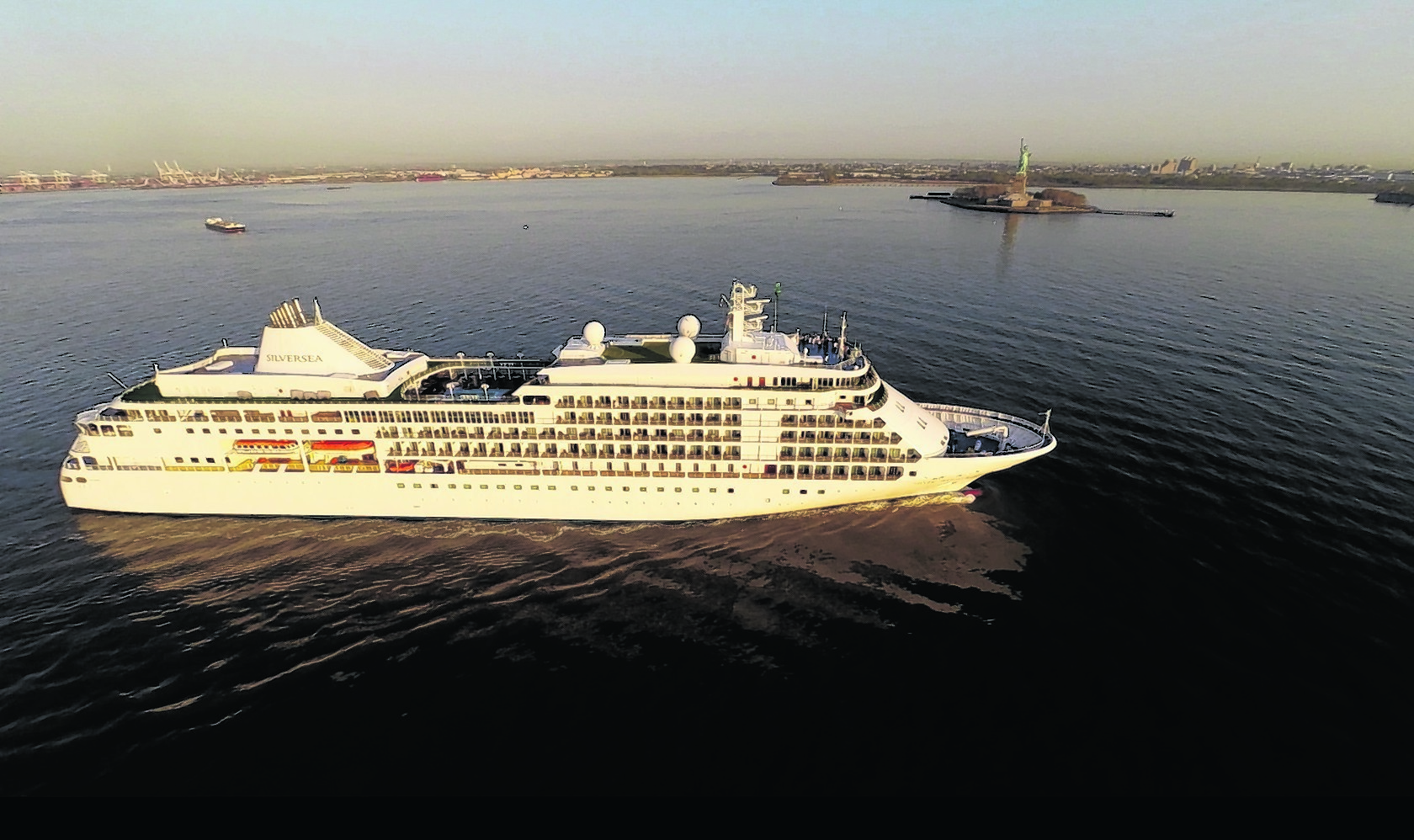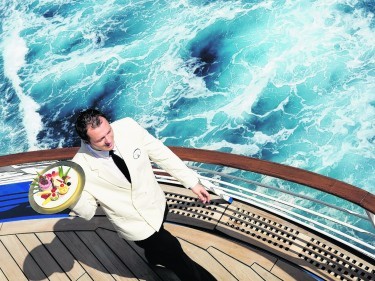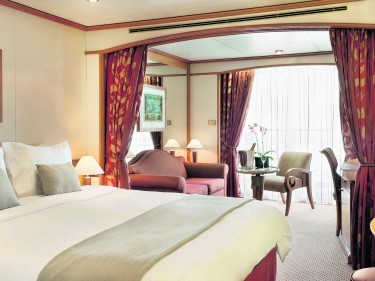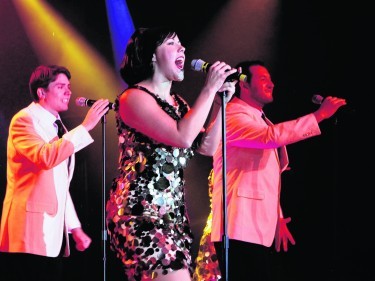Why is it different? Among other things, you’re almost exclusively with a grey-haired crowd. For another, there are fewer ports with half the time spent in long, leisurely days at sea. Yet you don’t have to leave the ship for the most memorable experiences, often the simplest things.
Such as in the early morning seeing the Statue of Liberty, towering in faded green, emerging through a fine mist in New York harbour.
And after a day in New York, robust and gritty as ever, viewing the dappled beams from the statue’s torch across the water while three helicopters, lights blinking, circle its head; President Obama is in town. One is reminded that the State of Liberty is also now a symbol of the courage of New Yorkers following the atrocity of 9/11.
It’s simple, but strikingly memorable, too, seeing, as you relax in the ship’s Panorama Lounge, the huge orb of the sun sinking slowly into the horizon while the talented Filipino quartet deftly beats out the best of Gershwin and Porter.
Underlying it all, there’s the tinge of excitement as we recall the course of the Titantic 103 years ago although we’re miles from it and directions are reversed since Titanic was sailing from Southampton to New York. But, being in the northern spring, the timing is within a couple of weeks.
As we leave Halifax, Nova Scotia, once the entry port for Canada’s immigrants and from where boats were dispatched to recover bodies from the Titantic, Silver Whisper’s master, Captain Luigi Rutigliano, warns of storms, fog and melting ice from icebergs from a late, bitter winter. Waves reach seven metres and the decision is made to divert farther north – from the icebergs’ path – and bypass the scheduled port of Newfoundland.
Still we’re all happy, it seems, with the Silver Whisper as the destination. There’s a complement of 297 passengers from 11 nations – 52 Britons, the second-largest contingent after the US – in the 382 passenger-capacity ship. It has a sense of intimacy, no crowds, suites are spacious, most with verandas, the linen Pratesi, bathrooms Italian marble.
With more than one crew member per passenger on this cruise, there’s always a staff member hovering to meet every need. Our Filipino butler Rommel, in black tails, sets the table for our in-suite dining, shines shoes, even spectacles, ensures the fridge is stocked with champagne, beverages, whatever spirits desired on-call.
The restaurant’s cuisine is superb, not surprising given the partnership with Relais & Chateaux, noted for its fine restaurants worldwide. As hotel director, Frenchman Fabien Leconte puts it, in all modesty: “If you’re No 1 you would want to be associated with No 1.”
With Silversea’s transition from an initial customer base of 75% American to one that’s more diversified, he points to the challenge of meeting international expectations in culinary tastes and other areas, but concludes “we’ve come to a mix which is pretty right”.
Fabien Leconte is well experienced in the luxury market, having, as well as other major cruise lines, served on the Onassis family yacht Christina O after, abandoned, it was sold to investors who offered it for charter at $US45,000 a day, plus food and fuel.
We’re mentally stimulated by world-class speakers, such as international lawyer Dr Christopher Whalen whose credentials include as a barrister practising in Britain, the US and Germany, Oxford law faculty member, professor of law at Washington and Lee University, Virginia, lecturer at Bucerius Law School, Hamburg.
He gives powerful talks on the role and effectiveness of the UN and on “economic superpower”, the European Union, while there’s a leavening from other speakers with topics like “Prince George – the boy who would be king” and “The art of heraldry”.
Entertainers, too, have impressive credentials. Among them, Australian concert virtuoso violinist Ian Cooper – who composed and performed a symphony at the Sydney 2000 Olympics opening ceremony – is a guest artist of jazz trumpeter James Morrison and tours internationally, which he began as a child star. He wows audiences with a mix of classical, jazz, gypsy, Latin and Irish musical styles.
Opera lovers are entranced by performances by soprano Francesca Copertino and tenor Giovanni Palminteri from Rome’s Classical Music Conservatoire, there’s the universal appeal of Broadway shows and recreation of 1960 hits from the Beatles, Lulu and Dusty Springfield.
We can choose language classes in Italian, Spanish or French, play mahjong, poker or bridge, table tennis, join dance classes, take part in trivia quizzes, board games, learn how to mix cocktails, get fit under the direction of a trainer. Or simply contemplate, in silence, from the Observation Deck the whistle of the wind and endless, circular sweep of the Atlantic.
After 10 days there’s more rough weather, with the captain on the bridge all night, and another port, Foynes on Ireland’s west coast, cancelled. But the weather moderates as we head to Cobh, on Ireland’s south coast.
On the bridge, Captain Rutigliano recalls the rough conditions, tells me how radar picked up scores of pieces of the icebergs’ melting ice, but emphasises the ship’s safety procedures. “All the time the ship was sailing in safe conditions,” he assures. Of the Silver Whisper, where he has served for some 10 years, first as second-in-command, he says: “I feel at home – it is a beautiful ship.”
At Cobh, formerly Queenstown, we take the Titanic Experience, a recreation of the liner’s departure from her last port of call, where 123 – mostly emigrants – boarded. In what was the White Star Line’s ticket office, we’re issued with tickets as Edward Ryan, 24, and Mary Helen Mockler, 22, who were among the original 113 third class – steerage – passengers. Titanic comes to life through still images taken by Jesuit priest Father Frank Browne, who left before the ship’s sailing, and audio visual dramatisations.
We view the third class cabins with bunk beds and bench seating (main course roast beef, boiled potatoes) and the luxurious first-class accommodation with canopy double beds, Louis XVI and Queen Anne furniture. The recreation builds to the climax at 11.40pm on April 14, 1912, with the launch of lifeboats, distress rockets, panic, the massive ship breaking in two and plunging down.
We’re happy to learn that as Edward Ryan and Mary Mockler, my wife and I are among the 44 third class survivors.
We dodge cars and vans in the narrow streets of Fowey, on the river of the same name, on Cornwall’s south-western peninsula, where mediaeval and Georgian buildings merge. The tourist information centre has an exhibition of the town’s most famous resident, novelist Daphne du Maurier, her life and works.
A cross below the cliffs at the river’s entrance commemorates the visit, according to legend, of Jesus, with rich merchant Joseph of Arimathea who came to view local tin mines; Joseph later donating to Jesus the tomb he had prepared for himself.
The multimillion-pound Eden Project, a “global garden” of landscapes, ornamental plants and crops, developed in a former china clay pit, and the Lost Gardens of Heligan – gardens and woodlands sprawling over 80 hectares – are both within half an hour’s drive of Fowey.
A different cruise . . . but the warmth and spontaneous reaction of a packed theatre of passengers at the captain’s farewell, when the entire ship’s company parades before us, says, unmistakably, we’d do it all again.
Silver Whisper has 18- and 17-day transatlantic cruises from Southampton to Montreal, with four days at sea, on September 8, 2015 and September 6, 2016. Ports include Fowey, Cobh, Dublin, Belfast, Reykjavik, Narsarsuaq, L’Anse aux Meadows, Corner Brook, Newfoundland, and Quebec City, both in Canada. See www.silversea.com



